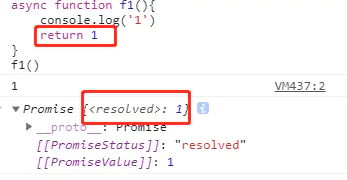今天抄一抄sweetBoy_9126的笔记:
- await后面接一个会return new promise的函数并执行它
- await只能放在async函数里
使用async和await获取成功的结果:
function 摇色子(){ return new Promise((resolve, reject)=>{ let sino = parseInt(Math.random() * 6 +1) setTimeout(()=>{ resolve(sino) },3000) }) } async function test(){ let n =await 摇色子() console.log(n) } test()
上面这段代码async中使await 摇色子()先执行,等到三秒后执行完再把得到的结果赋值给左边的n,也就是说test函数需要三秒钟才执行完成,所以test函数是异步的,因此前面必须写async;
获取失败的结果:
function 摇色子(猜测){ return new Promise((resolve, reject)=>{ let sino = parseInt(Math.random() * 6 +1) if(sino > 3){ if(猜测 === '大'){ resolve(sino) }else{ reject(sino) } }else{ if(猜测 === '大'){ reject(sino) }else{ resolve(sino) } } setTimeout(()=>{ resolve(sino) },300) }) } async function test(){ try{ //把await及获取它的值的操作放在try里 let n =await 摇色子('大') console.log('赢了' + n) }catch(error){ //失败的操作放在catch里 console.log('输了' + error) } } test()
把await和成功后的操作放到try里,失败的放在catch
-
为什么要用await
为了使我们的异步代码,更像同步的代码 -
有多个promise,怎么拿到所有的promise都结束后的结果
比如有两个色子,我想得到这两个色子的点数
1.使用promise:
function 摇色子(猜测){ return new Promise((resolve, reject)=>{ let sino = parseInt(Math.random() * 6 +1) if(sino > 3){ if(猜测 === '大'){ resolve(sino) }else{ console.log('error') reject(sino) } }else{ if(猜测 === '大'){ console.log('error') reject(sino) }else{ resolve(sino) } } setTimeout(()=>{ resolve(sino) },300) }) } Promise.all([摇色子('大'),摇色子('大')]).then((x)=>{console.log(x)},(y)=>{console.log(y)})
promise.all里面跟一个数组,数组的每一项是一个返回promise的函数调用,then的第一个参数是所有的promise都成功后调用,拿到所有promise的结果是一个数组;第二个参数拿到的是第一个失败的值
- 使用await
await是直接获取多个promise的结果的,因为Promise.all()返回的也是一个promise所以如果要使用await拿到多个promise的值,可以直接await Promise.all()
async function test(){ try{ let n = await Promise.all([摇色子('大'),摇色子('大')]) console.log(n) }catch(error){ console.log(error) } } test()
async函数会返回一个promise,并且Promise对象的状态值是resolved(成功的);
如果你没有在async函数中写return,那么Promise对象resolve的值就是是undefined:

如果你写了return,那么return的值就会作为你成功的时候传入的值:

await 等到之后,做了一件什么事情?
那么右侧表达式的结果,就是await要等的东西。
等到之后,对于await来说,分2个情况
- 不是promise对象
- 是promise对象
如果不是 promise , await会阻塞后面的代码,先执行async外面的同步代码,同步代码执行完,再回到async内部,把这个非promise的东西,作为 await表达式的结果。 如果它等到的是一个 promise 对象,await 也会暂停async后面的代码,先执行async外面的同步代码,等着 Promise 对象 fulfilled,然后把 resolve 的参数作为 await 表达式的运算结果。
如果asycn里的代码都是同步的,那么这个函数被调用就会同步执行:
async function fn(){ console.log('a') } fn() console.log('b') //a //b
如果在await后面接的这个promsie都是同步的,后面的promise会同步执行,但是拿到这个值还是得等待(特别注意:如果promise没有一个成功的值传入,对await来说就算是失败了,下面的代码就不会执行),所以不管await后面的代码是同步还是异步,await总是需要时间,从右向左执行,先执行右侧的代码,执行完后,发现有await关键字,于是让出线程,阻塞代码:
function fn(){ return new Promise(resolve=>{ console.log(1) }) } async function f1(){ await fn() console.log(2) } f1() console.log(3) //1 //3
这个代码因为fn是属于同步的,所以先打印出1,然后是3,但是因为没有resolve结果,所以await拿不到值,因此不会打印2
function fn(){ return new Promise(resolve=>{ console.log(1) resolve() }) } async function f1(){ await fn() console.log(2) } f1() console.log(3) //1 //3 //2
这个代码与前面相比多了个resolve说明promise成功了,所以await能拿到结果,因此就是1 3 2